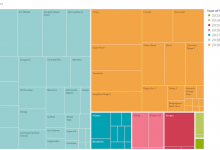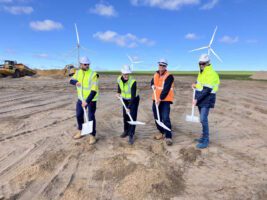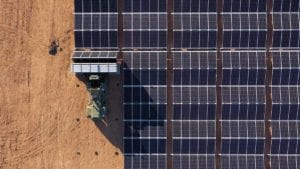A total of 23 large-scale solar farms were connected to the Australian electricity grid in 2019 – a year that was Complicated for big solar projects, but record breaking in almost every other way, including for solar system costs.
According to a comprehensive 127-page Year in Review report published by solar industry analysts SunWiz on Tuesday, 2019 was deceptively tough for large-scale solar projects, thanks to a hot mess of “contractor disputes, lawsuits, economic woes of EPCs, grid connection hold-ups, synchronous condensers, MLF adjustments, curtailment, and negative wholesale power prices.”
Despite all of this, 23 solar farms powered up over the course of the year, ranging from John Laing’s 175MW Finley Solar Farm, a NSW project that is contracted to sell power to BlueScope Steel, to the 4MW solar farm commissioned by EDL at the Agnew gold mine in the northern goldfields in Western Australia.
 SunWiz’s Warwick Johnston notes that the large-scale market has shown a trend towards smaller grid-connected projects in 2019, with a 30 per cent decrease in the number of projects exceeding 10MW in size taking the year’s total to 1.3GW in 2019, down from 1.8GW in 2018.
SunWiz’s Warwick Johnston notes that the large-scale market has shown a trend towards smaller grid-connected projects in 2019, with a 30 per cent decrease in the number of projects exceeding 10MW in size taking the year’s total to 1.3GW in 2019, down from 1.8GW in 2018.
And while the second chart below illustrates how 2019 fell short of 2018 in total capacity, the list of newly commissioned solar farms in 2019 includes some pretty interesting projects in its number.
Among these, Johnston notes Meralli Solar’s 9MW Kanowna solar farm, which as reported here on RenewEconomy is a “small-but-smart” project that uses DC optimisers and DC-battery charging, plus densely-packed BElectric framing, all installed in 10 weeks.
Another project that got a lot of RenewEconomy’s attention in 2019 was the world-leading wind, solar and battery storage hybrid renewables project at Kennedy Energy Park in north Queensland.
The 62MW project – 15MW of which is solar PV – was one of the many projects that were held back by connection delays, and left sitting idle for months, waiting to be energised.
Another project of note to join the grid last year was Neoen Australia’s Numurkah solar farm in Victoria, which was connected to landmark deals to power both the Laverton steel works and Melbourne’s network of trams.
Meanwhile, Australia’s rooftop market continued to thrive – as we reported here last week – in both the residential and commercial sectors. And no wonder, as already low system prices made their way further down the curve to a new low.
As the below chart of system prices from SunWiz shows, solar power has reached record-low prices in Australia, having charted another 8% fall in 2019.
This has made access to solar power for households and businesses “as cheap as it has ever been,” Johnston says – even without making the “grave” mistake of skimping on quality.
“The good news is a quality solar power system that will pay for itself multiple times over its long lifetime: quality is now really affordable!”










